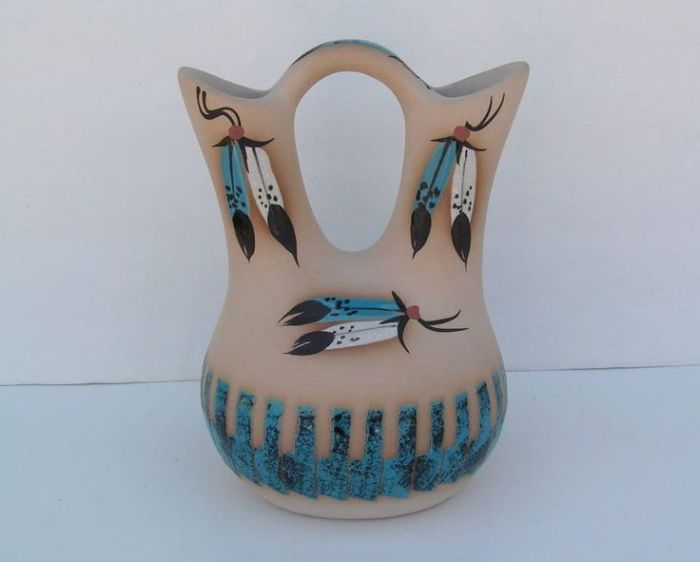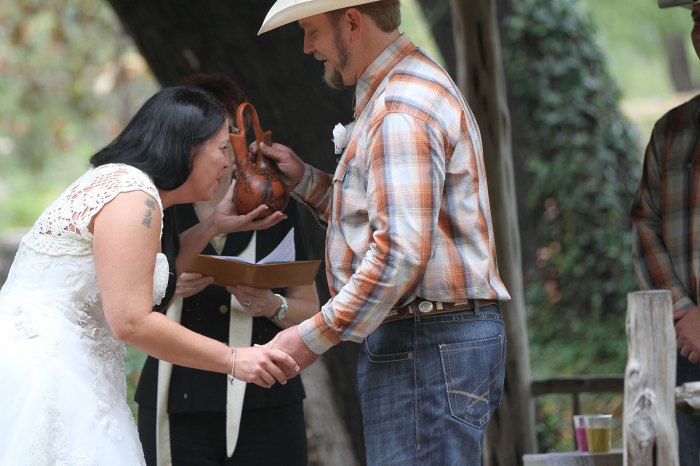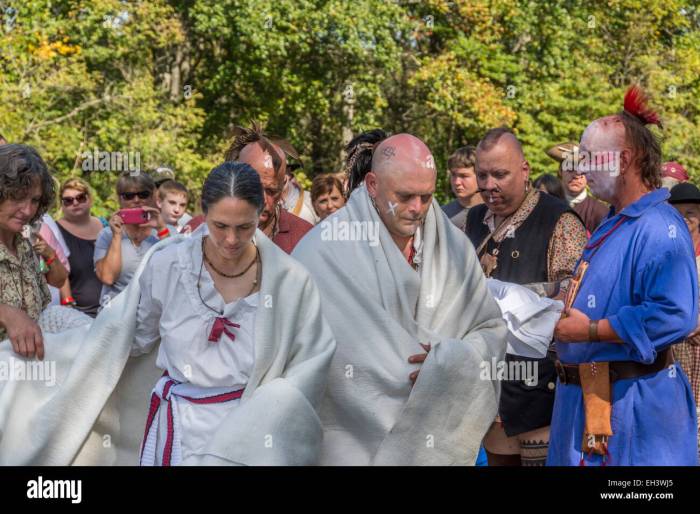Traditional Cherokee Wedding Dress A Cultural Tapestry
Historical Evolution of Cherokee Wedding Attire
Traditional cherokee wedding dress – Cherokee women’s clothing, and consequently wedding attire, has undergone significant transformations throughout history, reflecting evolving cultural interactions and societal shifts. From pre-contact styles to contemporary interpretations, the journey of the Cherokee wedding dress offers a rich tapestry of cultural expression.
Evolution of Cherokee Women’s Clothing
Before European contact, Cherokee women primarily wore clothing made from natural materials like deerskin and woven fabrics from plants such as hemp and nettle. These garments were often simple in design but practical and functional, adapted to the environment and lifestyle. Post-contact, the introduction of European textiles and fashion significantly impacted Cherokee clothing. The adoption of new materials and styles led to a blend of traditional and European influences, evident in the evolution of Cherokee wedding attire.
Influence of Historical Periods and Cultural Exchanges
The 18th and 19th centuries saw increased interaction with European settlers, resulting in the incorporation of European fabrics and tailoring techniques into Cherokee clothing. However, traditional elements were often retained, creating a unique fusion of styles. The late 19th and early 20th centuries brought about further changes, with the influence of missionary clothing styles becoming more prominent. The mid-20th century saw a resurgence of interest in traditional Cherokee arts and crafts, influencing a renewed focus on preserving traditional clothing styles.
Comparison of Traditional and Contemporary Attire
Traditional Cherokee wedding dresses were typically characterized by simple, flowing lines, often featuring natural dyes and intricate beadwork. Contemporary interpretations maintain these core elements but often incorporate modern fabrics and embellishments, reflecting a balance between tradition and contemporary aesthetics. While some contemporary dresses closely resemble historical styles, others incorporate modern design elements while retaining cultural significance.
Timeline of Cherokee Wedding Dress Changes
| Era | Description of Dress | Materials Used | Notable Features |
|---|---|---|---|
| Pre-Contact | Simple, functional garments made from deerskin and woven plant fibers. | Deerskin, hemp, nettle fiber | Practical designs, minimal embellishment. |
| Post-Contact (18th-19th Centuries) | Blending of traditional and European styles; introduction of European fabrics. | European textiles, deerskin, beads | Fusion of traditional silhouettes with European fabrics and embellishments. |
| Early 20th Century | Increased influence of missionary styles; simpler designs. | Cotton, calico, purchased fabrics | Less intricate beadwork and embellishment. |
| Mid-20th Century to Present | Resurgence of interest in traditional styles; incorporation of modern materials and techniques. | Variety of fabrics, beads, traditional dyes | Modern interpretations of traditional designs, emphasis on cultural preservation. |
Components of a Traditional Cherokee Wedding Dress
A traditional Cherokee wedding dress is composed of several key elements, each carrying symbolic meaning and reflecting cultural values. The construction and decoration of these elements are integral to the dress’s overall significance.
Key Components and Their Symbolism
The primary components typically include a long skirt, an overdress or shawl, and various forms of jewelry. The skirt, often made of woven fabric, represents the earth and grounding. The overdress, often decorated with intricate beadwork or embroidery, can symbolize protection and spiritual connection. Shawls, if included, add an extra layer of warmth and often feature symbolic patterns. Jewelry, including necklaces, earrings, and bracelets, often carries specific symbolic meanings related to family, lineage, and spiritual beliefs.
Techniques and Methods of Creation, Traditional cherokee wedding dress
Traditional Cherokee wedding dresses are often handcrafted, utilizing techniques passed down through generations. Weaving, dyeing, and beadwork are prominent methods. Natural dyes derived from plants and minerals were traditionally used, resulting in a range of earthy tones. Intricate beadwork patterns often depict significant symbols or tell stories, showcasing the skill and artistry of the creator. The process of creating a dress is itself a significant cultural act, often involving family and community members.
Detailed Description of a Traditional Dress
Imagine a dress with a long, flowing skirt of dark indigo, woven from locally sourced cotton. Over this, a lighter-colored overdress, perhaps in a muted red or brown, is draped. Intricate beadwork in geometric patterns, possibly depicting clan symbols or sacred imagery, adorns the overdress. A simple shawl in a complementary color is draped over the shoulders, adding warmth and a touch of elegance.
Silver or turquoise jewelry, passed down through generations, completes the ensemble, representing the wearer’s heritage and connection to her ancestors.
Regional Variations in Cherokee Wedding Dress: Traditional Cherokee Wedding Dress
While sharing common elements, Cherokee wedding attire exhibits regional variations across different Cherokee Nation bands, reflecting local traditions and available resources. These variations manifest in the styles, materials, and embellishments used in the dresses.
Regional Style Differences
- Eastern Band of Cherokee Indians: Dresses might feature more intricate beadwork and the use of specific color combinations reflecting local traditions.
- Cherokee Nation in Oklahoma: Styles may incorporate influences from other Native American groups in the region, leading to a unique blend of traditions.
- United Keetoowah Band of Cherokee Indians: Specific patterns or motifs in beadwork or embroidery may be unique to this band, reflecting their distinct cultural heritage.
Geographical Distribution of Variations
A textual map illustrating regional variations would show the Eastern Band in the Appalachian Mountains of North Carolina, the Cherokee Nation primarily in Oklahoma, and the United Keetoowah Band also in Oklahoma, but with potentially some distinctions in their traditional styles compared to the larger Cherokee Nation.
Modern Interpretations of the Traditional Cherokee Wedding Dress
Contemporary Cherokee women creatively incorporate traditional elements into their wedding attire, demonstrating a commitment to preserving cultural heritage while adapting to modern contexts. This involves careful consideration of authenticity and the challenges of using modern materials.
Incorporating Traditional Elements
Modern interpretations often feature elements like traditional beadwork, embroidery patterns, or specific color palettes. Modern fabrics might be used, but the overall silhouette or design might closely mirror historical styles. Some brides might choose to incorporate family heirlooms, such as jewelry or fabric from older dresses, into their contemporary designs.
Challenges and Considerations

Source: pinimg.com
Preserving authenticity while adapting to modern contexts requires careful consideration. Sourcing traditional materials can be challenging, and finding artisans skilled in traditional techniques requires effort. Balancing the desire for a modern aesthetic with the need to maintain cultural significance requires sensitivity and respect for tradition.
Comparison of Traditional and Modern Dresses
Modern dresses often retain the flowing silhouette and use of natural dyes, but might utilize modern fabrics like silk or linen. Beadwork and embroidery might be simplified or adapted to modern tastes, but the underlying symbolic meaning is often preserved. The overall goal is to create a dress that honors tradition while reflecting the bride’s individual style and modern sensibilities.
The Role of Color and Symbolism in Cherokee Wedding Attire
Color plays a significant role in traditional Cherokee wedding attire, conveying cultural values, beliefs, and spiritual significance. Specific colors and patterns carry deep symbolic meanings, reflecting the wearer’s connection to her heritage and the natural world.
Significance of Color and Patterns

Source: ltkcdn.net
Colors like deep indigo, representing the earth and stability, were commonly used. Red, symbolizing strength and vitality, might also be featured. Geometric patterns often held specific meanings, representing clan affiliations or spiritual concepts. The choice of colors and patterns was not arbitrary but carefully considered, reflecting the bride’s identity and connection to her community.
Color Choices and Cultural Values
The use of natural dyes and the avoidance of bright, unnatural colors reflected a respect for the natural world and a preference for understated elegance. The intricate patterns demonstrated the skill and artistry of the creator, showcasing the importance of craftsmanship within Cherokee culture. The overall aesthetic conveyed a sense of balance, harmony, and connection to the spiritual realm.
Examples of Color Combinations and Meanings

Source: alamy.com
- Indigo and red: Earthiness and vitality.
- Brown and ochre: Connection to the land and natural resources.
- Muted greens and blues: Harmony and balance.
Illustrative Descriptions of Traditional Cherokee Wedding Dresses
The following examples highlight the diversity and artistry of traditional Cherokee wedding dresses, emphasizing their unique features and cultural significance.
Examples of Traditional Dresses
- Dress 1: A flowing deerskin dress, adorned with intricate quillwork depicting clan symbols. The natural color of the deerskin is accented by subtle quillwork in shades of brown and black, showcasing a connection to the natural world and ancestral heritage. The simplicity of the design highlights the beauty of the natural materials.
- Dress 2: A long skirt of woven cotton dyed a deep indigo, layered with an overdress of lighter-colored woven fabric embellished with geometric patterns in red and white beadwork. The patterns symbolize specific clan affiliations and spiritual beliefs, demonstrating the wearer’s identity and connection to her community. The combination of colors and patterns creates a visually stunning and culturally rich garment.
- Dress 3: A dress made from a combination of hand-spun cotton and commercially-produced fabrics, showcasing the blending of traditional and modern resources. The skirt is a deep brown, accented by a woven overdress with embroidered floral patterns, possibly reflecting both traditional and post-contact influences. The use of both traditional and modern materials demonstrates adaptability and cultural resilience.
FAQs
What materials were traditionally used in Cherokee wedding dresses?
Traditionally, Cherokee wedding dresses utilized natural materials readily available, such as hand-spun cotton, wool, and deerskin. Plant-based dyes provided vibrant colors.
Are there specific ceremonies or rituals associated with the wearing of a traditional Cherokee wedding dress?
While specific ceremonies vary among different Cherokee bands, the wedding dress itself often holds symbolic significance representing the bride’s connection to her heritage and community.
Where can I find examples of traditional Cherokee wedding dresses?
Traditional Cherokee wedding dresses often feature intricate beadwork and symbolize the bride’s connection to her heritage. The cost of such handcrafted garments can vary widely, much like the price range for other elaborate wedding attire, such as the romany gypsy wedding dresses cost , which are known for their vibrant colors and lavish embellishments. Ultimately, the expense of a Cherokee wedding dress depends on the level of detail and the artisan’s skill.
Museums showcasing Native American artifacts and cultural centers within the Cherokee Nation often display examples or have information about traditional attire. Scholarly articles and books on Cherokee culture may also provide visual references.
How are modern Cherokee women incorporating traditional elements into their weddings today?
Modern interpretations often incorporate traditional colors, patterns, and symbolic elements into contemporary designs, blending traditional aesthetics with modern styles. This reflects a conscious effort to honor heritage while adapting to contemporary contexts.



















